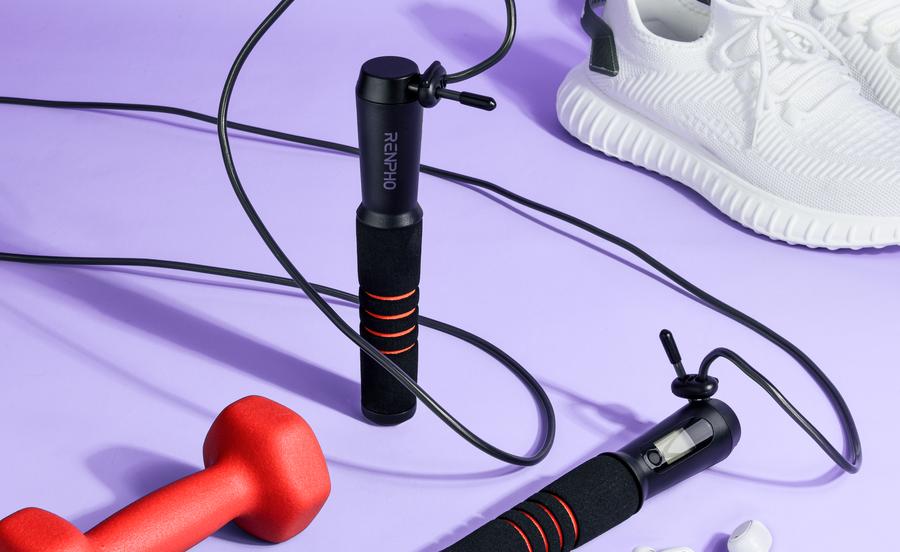Updated on March 11, 2024 by Joash Guevarra
When it comes to fitness and cardio workouts, skipping rope is a classic and effective exercise that can be done anywhere, anytime. Whether you're a beginner or a seasoned fitness enthusiast, using the right skipping rope length is essential for maximising your workout and preventing unnecessary strain or injury. The question is, how do you determine the perfect rope length for your skipping routine?
How to Measure a Jump Rope?
By following a step-by-step process, you can ensure that the rope is the correct length for optimising your performance during workouts and activities.
- Start by finding a clear and open space where you can easily handle the jump rope. Stand on the middle of your fully assembled jump rope
- Hold the left side handle at a horizontal angle and pull the rope taut, with minimal sag or slack.
- Measure up to your underarm and use the adjustable fastening clip to tighten off the remaining slack.
- Test the performance of the jump rope by performing a few jumps. The rope should smoothly rotate around you, without hitting the ground or getting tangled.
- Repeat on the above steps for the right side handle and you’ve now successfully made the adjustments needed for maximum skipping comfort.
By following these step-by-step instructions, you can accurately measure a jump rope, ensuring it is the ideal length for your workout routine.
Why Is Jump Rope Length Important?
Jump rope length plays a crucial role in ensuring an efficient and effective workout. Whether you are a beginner or an experienced jumper, having the right length is essential for enhancing your performance and reducing the risk of injury.
Firstly, the right length ensures proper form and technique during your skipping routine. When the rope is too long or too short, it can throw off your rhythm and timing, making it more challenging to maintain a consistent jumping motion. Having the correct length allows you to jump smoothly, helping you to develop a fluid and efficient skipping technique.
Secondly, the appropriate length can help prevent injuries. If the rope is too long, it may drag on the ground and increase the risk of tripping or getting tangled. On the other hand, if the rope is too short, it can lead to excessive strain on your joints, particularly in your ankles and knees, as you may have to jump higher to clear the rope. By using the right jump rope length, you can minimise the likelihood of accidents and protect your body from unnecessary stress.
Furthermore, length is crucial for achieving the desired workout intensity. Different rope lengths can affect the speed and resistance of your jumps. A longer rope allows for slower rotations, making it suitable for beginners or those focusing on endurance training. Conversely, a shorter rope enables faster rotations, increasing the intensity and targeting your cardiovascular system more intensely. By selecting the appropriate length, you can tailor your workout to meet your specific fitness goals, whether it's improving endurance, burning calories, or enhancing agility.
Lastly, length is a matter of personal comfort. Each individual has unique body proportions and jumping styles, so what works for one person may not work for another. Finding the right rope length that feels comfortable and natural for you can greatly enhance your overall skipping experience. It allows you to maintain a relaxed posture, reduce muscle tension, and enjoy your workout without unnecessary strain or discomfort.
How Long Should a Jump Rope Be?
When determining the appropriate length for a jump rope, several factors need to be considered. One of the primary factors is the individual's height. A jump rope that is too long or too short can hinder proper jumping technique and effectiveness. As a general rule, it should be approximately 91 cm taller than the height of the individual using it. However, this is just a starting point, and adjustments may be necessary based on other factors.
An important factor to consider is adjustability. Many jump ropes come with the option to adjust the length. This allows individuals to customise the length to their exact needs, ensuring optimal performance. It also allows for flexibility and adaptability for different types of skipping styles. For example, some skipping techniques require a longer rope for tricks and routines, while others may need a shorter rope for speed and agility training.
Moreover, the length of the jump rope may need to be adjusted when sharing with others. Jump ropes are often used in fitness classes or group workouts, where individuals of different heights participate. Having an adjustable jump rope ensures that it can be easily shared among participants without compromising their jumping experience.
How to Tell If Your Jump Rope Is Too Short
If you suspect that your jump rope may be too short, there are specific signs and symptoms you can look out for to confirm your suspicion. One key sign is if you consistently find yourself jumping higher than necessary to clear the rope.
When a jump rope is too short, you will need to jump higher to prevent it from hitting the ground or tangling with your feet. This can lead to excessive strain on your calf muscles and decreased efficiency in your workout. If you notice yourself consistently jumping higher than usual, it may be time to consider whether your jump rope is too short.
Another symptom to look out for is the rope constantly hitting your feet during your jump rope sessions. If the rope consistently brushes against your feet or trips you up, it is a clear indication that the length is inadequate for your height. The rope should ideally clear your feet by a few inches as it passes under them, allowing for smooth, uninterrupted jumps.
How to Find the Perfect Jump Rope for You
Finding the perfect jump rope that suits your needs and preferences can be a daunting task with the wide variety of options available in the market today. With factors such as material, length, weight, and handle style to consider, it is important to have a clear understanding of your goals and requirements before making a purchase.
General Fitness
Jump rope exercises are a great way to improve general fitness and target various areas of the body. They provide numerous benefits such as cardiovascular conditioning, agility, coordination, and endurance. Let's look at a few of these exercises and their target areas along with proper form and technique.
- Basic Jump: This is a fundamental jump rope exercise that targets the calves, quads, and shoulders. Start with the rope behind you, elbows close to the body, and jump over the rope with both feet together. Maintain an erect posture, relaxed shoulders, and land softly on the balls of your feet.
- High Knees: This exercise primarily targets the core, hips, and thighs. With a faster pace, lift each knee up as high as possible while jumping over the rope. Engage your core, keep your back straight, and maintain a steady rhythm.
- Side Swings: This exercise focuses on the obliques, shoulders, and arms. Swing the rope side to side in a fluid motion while jumping over it. Keep your arms slightly relaxed and use your wrists to create the swinging motion.
To enhance the effectiveness of jump rope exercises, consider using weighted handles or an adjustable rope. Weighted handles add resistance, increasing upper body strength, and an adjustable rope ensures proper length for different heights.
Remember, maintaining proper form is crucial for injury prevention and getting the most out of your workouts. Keep your head up, maintain good posture, and synchronise your jumps with the rope's rotation. With practice, you'll be able to increase intensity, target specific areas, and achieve your general fitness goals.
Freestyle
Freestyle jumping with a jump rope is an art that requires control and a deep understanding of personal preferences. When performing tricks and acrobatics with a jump rope, it is crucial to have complete control over the movements to create a mesmerising performance.
One key aspect to consider in freestyle jumping is the clearance between the rope and the head. Maintaining a clearance of six to 14 inches ensures optimal performance and reduces the risk of hitting the head during the jumps. This clearance allows for fluid movements and gives enough space to perform high jumps and intricate tricks without any hindrance.
However, it is important to note that the ideal rope length for freestyle jumping may vary from person to person. Personal preferences, body proportions, and skill level can all contribute to finding the perfect rope length. It is encouraged to play around, test different lengths, and adapt to find what works best for individual needs.
Speed
When it comes to adjusting the speed rope length, there are a few factors one should consider to maximise performance and ensure efficient use. The length of the speed rope is directly related to speed, agility, and overall comfort during the workout.
One factor to consider is the user's height. A taller individual might require a longer rope length to accommodate their longer limbs, while a shorter person may opt for a shorter length for better control and speed. It's important to find a length that allows for proper form and allows the rope to smoothly rotate without hitting the ground or creating excess drag.
The purpose of speed ropes is to enhance cardiovascular endurance, speed, and agility. Speed ropes are designed to be lightweight, allowing for quick rotation and fast movements. This lightweight design reduces fatigue and allows users to maintain a high tempo during workouts. Additionally, speed ropes often feature ball bearings in the handles, which provide smooth and effortless rotation. This feature further enhances speed and prevents the rope from tangling.

Watch the video below to see the RENPHO Smart Jump Rope in action or click here to learn more about its unique product features.




